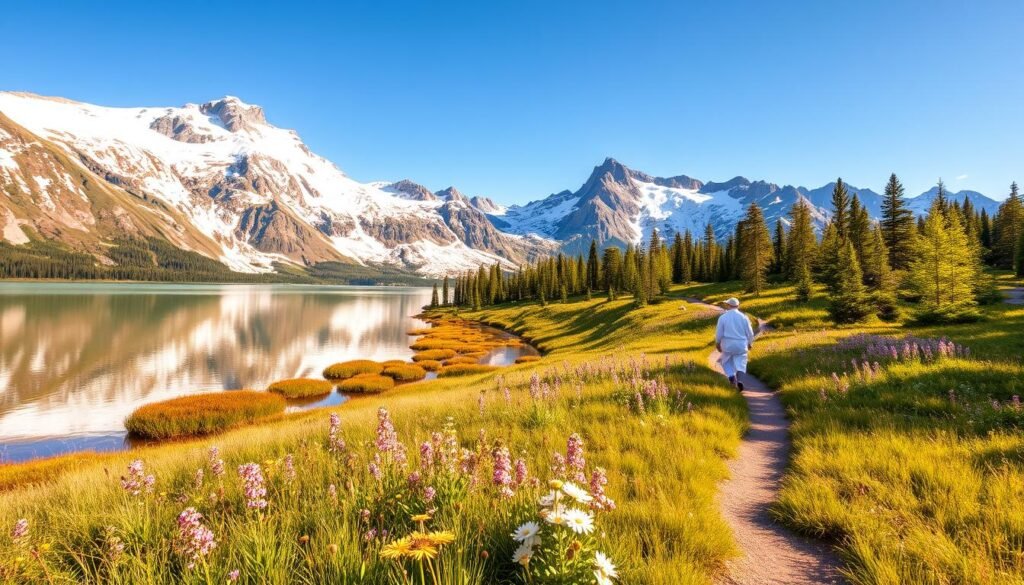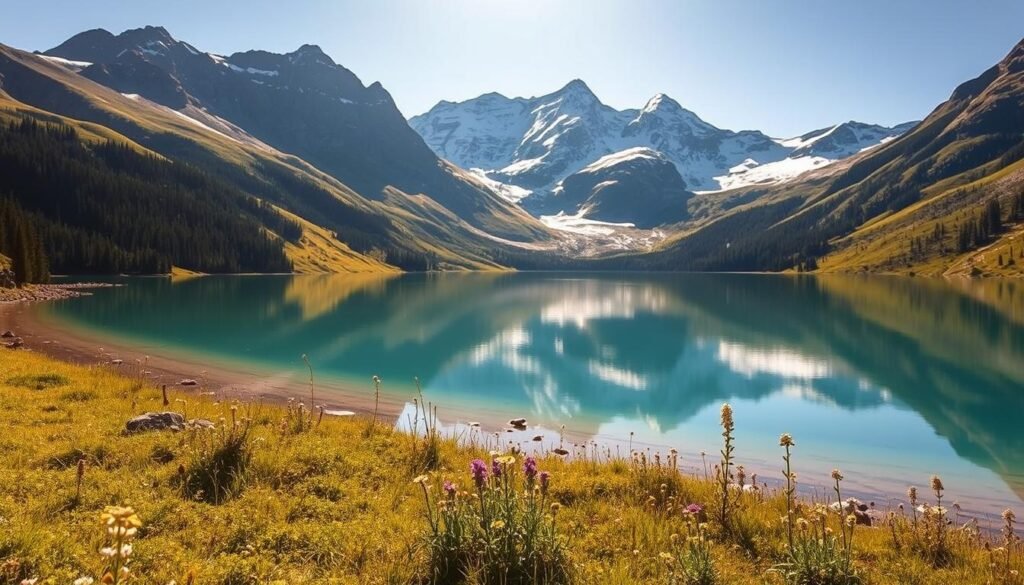Did you know that peak season here concentrates in just six weeks each summer, yet the park’s real magic appears across the whole year?
I wrote this short guide so you can match season and goals—hiking, wildlife, quiet trails, or stunning fall color—without guesswork. I explain how the Continental Divide shapes weather on each side, and how that affects access and safety.
Spring brings rushing waterfalls and early bike rides on Going-to-the-Sun. Summer opens main routes and backcountry options for hikers. Fall rewards solitude and golden larch, while winter offers quiet snowscapes and Nordic fun.
I’ll also point out when marquee areas usually open and when I swap plans for changing conditions. If you want a deeper schedule, see my linked planner for detailed windows and practical tips: when to visit.
Key Takeaways
- Peak crowds cluster in early July through Labor Day; shoulder seasons offer calm.
- Weather shifts across the Continental Divide—pack layers and plan for swings.
- Spring favors waterfalls and biking; summer opens main roads and trails.
- Fall brings golden larch and fewer people; winter is for snow activities.
- I provide timing tips so your trip matches the sights you want most.
How I Decide the Best Time to Visit Based on Weather, Roads, and Crowds
I match your trip goals with seasonal realities so you get the experiences that matter most. I first ask whether you want alpine drives, alpine hiking, cycling, wildlife viewing, or quiet time. That answer guides which season and routes I recommend.
I pay close attention to the-sun road because the full route usually opens only after plowing and avalanche work. In most years that falls between late June and mid-July, and a heavy snow year can push those dates later.You can learn more about best-european-countries-to-visit
My quick take: match your trip to your goals
If hiking, I wait for high-elevation hiking trails to clear—often early July—while suggesting lower trails in May and June.
If cycling, spring car-free segments on the-sun road can be ideal, but snow and conditions change rideability week by week.
Going-to-the-Sun Road realities: why opening dates drive your itinerary
- I plan alpine drives from late July through September and keep lower-elevation backups if dates slip.
- Peak crowds run July 4 through Labor Day, so I aim late June or September for fewer people and solid access to Logan Pass.
- I always check the week-of conditions because the Continental Divide creates stark weather differences across the park.
For a detailed planner and current windows on when the full route usually opens, see my linked guide: when the full route usually opens. Flexible itineraries and refundable lodging make adapting to changing dates much easier.
The best time to visit Glacier National Park by season: spring, summer, fall, and winter

I sort the months by access and activities so you can match plans with what’s actually open and safe. Below I note what I watch for in each season and how I change my route and gear.You can learn more about best-time-to-visit-morocco
Spring (March–May)
Quiet mornings and big meltwater define spring. Lower trails often clear by mid‑April and portions of the-sun road are plowed for cyclists in May.
Waterfalls peak during snowmelt, and the Middle Fork Flathead runs biggest from May through mid‑June — ideal for whitewater trips. I often plan rides from West Glacier toward Logan Pass when conditions allow.
Summer (June–August)
By late July the full route is usually open and visitor centers, lodges, and campgrounds are operating. Long days favor hikes to Logan Pass, swims at Lake McDonald, and trips to Iceberg Lake.
Tip: I start early, use transit or bikes, and avoid lunch crowds so I still get quiet time on popular trails.
Fall (September–November)
Fall brings golden larch and thinner crowds. West-side color often peaks mid‑September, with the east side following in early October.You can learn more about best-time-to-visit-aruba
I focus on Garden Wall and Hidden Lake vistas, fishing, and scenic floats while expecting parts of the-sun road to be limited by October.
Winter (December–February)
Deep snow closes most services until spring, though Apgar Visitor Center runs weekends and some roads are plowed to Apgar and Lake McDonald Lodge.
When conditions allow, I snowshoe or cross‑country ski on closed corridors for a serene view of the lake and backcountry.
If you need current hours and road status before you go, check updated visitor and road info on the park hours page: current park hours and road status.
Essential planning: weather ranges, opening dates, road status, and safety I always check
I start every plan with a short scan of seasonal temperatures and current reports so my route and gear match the day. The park crosses the Continental Divide, so west and east sides can feel very different on the same morning.
Temperature guide and split weather patterns
Average ranges help me pack: March–May roughly 57°F/31°F, June–August about 77°F/43°F, September–November near 53°F/32°F, and December–February around 32°F/20°F.
Road status and opening dates
I watch the-sun road closely. The full route typically opens late June to mid‑July, while lower sections remain accessible much of the year.
| Season | Avg High / Low (°F) | Road & access notes |
|---|---|---|
| Spring (Mar–May) | 57 / 31 | Lower roads clear first; cyclists use plowed segments in May. |
| Summer (Jun–Aug) | 77 / 43 | Full the-sun road often open by late June–mid‑July; visitor services active. |
| Fall (Sep–Nov) | 53 / 32 | Color peaks mid‑Sep to early Oct; expect partial closures by October. |
| Winter (Dec–Feb) | 32 / 20 | Most services closed; some roads plowed to low-elevation areas. |
Trail status, river levels, and gear checklist
I verify hiking trails and closures with trail reports and webcams so I can pick safe routes that match current conditions.
- Check Glacier National Park Road Status, trail reports, webcams, and river gauges.
- Review the Recreation Safety Forecast before rafting or fishing on the Middle and North Fork Flathead.
- Pack: rain shell, warm mid-layer, sun protection, extra food and water, bear spray, printed map.
- Tell someone your plan and set a firm turnaround time.
Conclusion
I focus on matching your goals with the right season and flexible plans. The most reliable mix of full access and thinner crowds often falls in late July and September. Shoulder months deliver waterfalls, bright fall color, and quieter trails if you plan for changing conditions and limited services.
If you want broad access and alpine drives, aim late July into September. If you prefer calm, lean into shoulder windows and keep lodging with flexible terms.You can learn more about best-time-to-visit-cancun
My bottom line: there isn’t one single best time visit for everyone. Choose your season, lock smart lodging, and build Plan A and Plan B so your trip enjoys the park’s views and lakes no matter what the day brings.





















